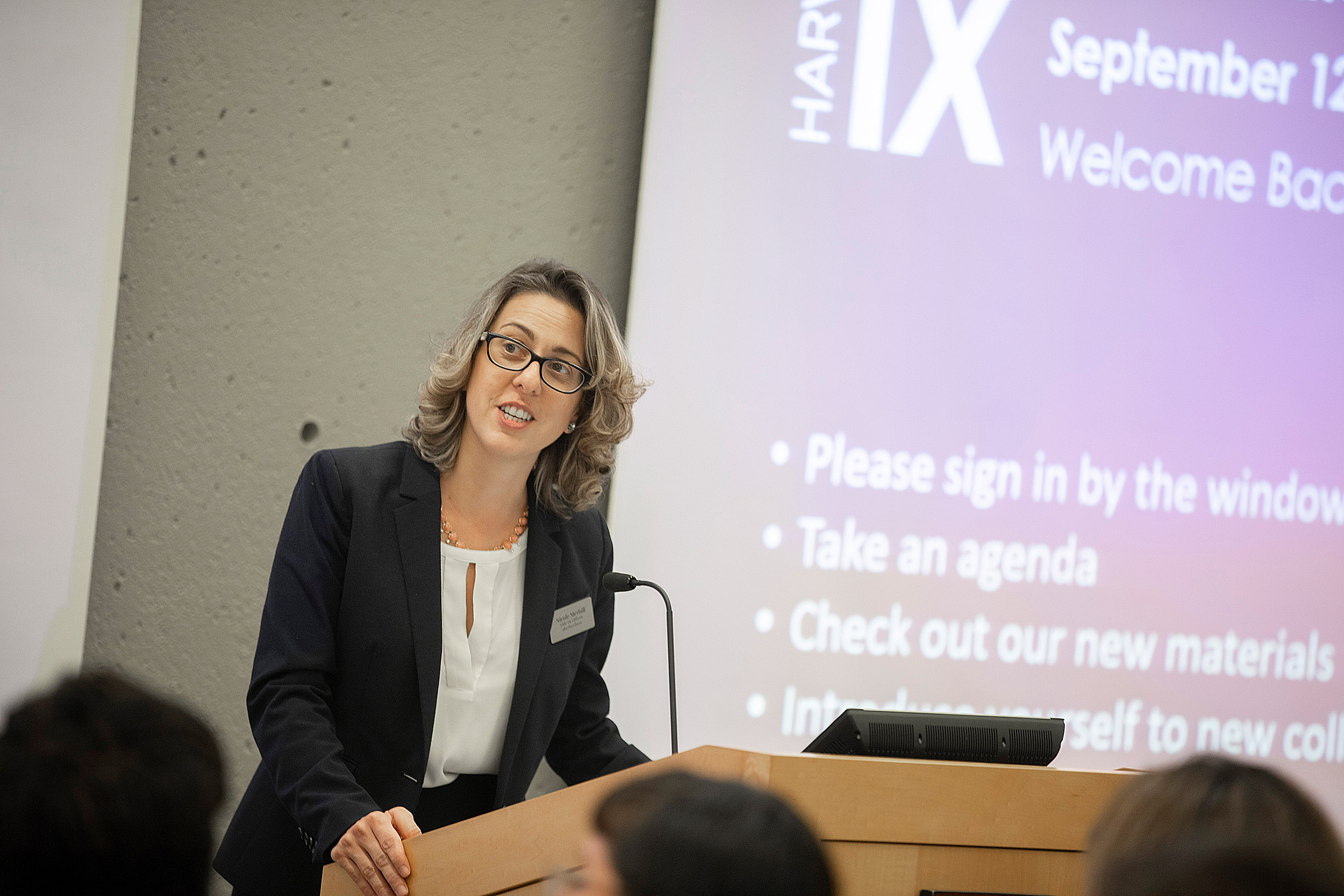
Nicole Merhill, Harvard’s Title IX officer, speaks at the academic year’s first Title IX coordinator meeting.
Kris Snibbe/Harvard Staff Photographer
Harvard adds to Title IX initiatives
Programs expand commitment to preventing and responding to sexual and gender-based harassment
Harvard University continues to expand on its commitment to prevent and respond to instances of sexual and gender-based harassment, including sexual assault, introducing several new initiatives this fall to serve students, faculty, and staff.
These initiatives, being rolled out by the University’s Title IX Office, include a student liaison committee to engage students in educating their peers about Title IX policies and resources on campus; hiring an education program manager to head the initiative and expand on the university’s training efforts; development of new required online training for all faculty and staff, as well as faculty and staff Title IX liaison committees; and the launch of a bystander intervention training program.
These efforts are being supported by more than 50 Title IX coordinators University-wide, up from 35 in 2014.
“Our fundamental goal is to be a leader in a culture shift around sexual and gender-based harassment on America’s campuses, by elevating and enhancing the work we are already doing here at Harvard,” said Nicole Merhill, the University’s Title IX officer. “We continue to strive to provide outreach, education, and prevention on a broader scale, while giving a greater voice to those who matter the most: the members of our community.”
Harvard President Larry Bacow underscored the importance of the office’s heightened efforts during the first Title IX coordinator meeting of the academic year.
“I consider it a large part of my job — and all of our jobs — to try to help create a community in which everybody feels welcome,” he said. “And I believe that, in order for each of us here at Harvard to be able to do our best work, we must strive to foster an environment that is free from harassment and an environment in which everybody feels valued, included, respected, and heard. Our work to this end is never done, and it’s my privilege to embark on this journey collectively, with all of you.”
Also expected next spring, the University will gather critical data around the state of the environment on campus by administering a Campus Climate Survey on Sexual Assault and Misconduct, being coordinated by the American Association for Universities. Harvard played a leading role in articulating the need for and helping design the 2015 association study, which was adopted by 28 research universities (including Harvard) and which shed light on the alarming frequency with which students, especially undergraduates, experience sexual assault. That survey also underscored that many students lacked confidence in Harvard’s response to reports of sexual misconduct, and lacked awareness of the resources and support available to them.
Much has changed since 2015 in terms of Title IX offerings on campus, yet it can take time to see impact. The new survey will illuminate areas where the University may need to provide additional resources.
This fall’s initiatives represent the latest steps aimed at better serving the Harvard community:
- The student liaison committee, to be overseen by Rachel DiBella, Title IX education program manager, will provide an opportunity for individuals across the University with a cross-section of perspectives to convene regularly and take stock of “what we’re doing, where there are gaps, and how to take things to the next level,” said Merhill. The committee will likely feature one or two students from each of Harvard’s Schools, and should begin meeting in October.
- Training to recognize and prevent sexual and gender-based harassment is not new at Harvard; over the past two years, more than 25,000 members of the community have completed the University’s online Title IX training module. What’s new this fall is that all faculty and staff are required to complete a common baseline of training. The decision to implement mandatory training was reached after wide consultation with leadership, including then-President Drew Faust, Bacow, and the Harvard Corporation. (All Harvard students already participate in online and/or in-person training as part of orientation.)
- Bystander intervention training will be offered to students, staff, and faculty, in-person, and will explore and grapple with potential opportunities to get involved in an individual’s work space, department, or classroom when instances of harassment occur. Those who would like to participate in a pilot session can sign up via the Title IX Office’s new website, which is designed to better connect community members with the resources they need.
This new programming supports the University’s Sexual and Gender-Based Harassment Policy, adopted in 2014. The Title IX Office leads on these initiatives and handles education and prevention; it also coordinates disclosures of sexual and/or gender-based harassment through its system of Title IX coordinators. A separate entity, the Office for Dispute Resolution, also established in 2014, investigates formal complaints of sexual and gender-based harassment as well as allegations outside the policy, at the request of Schools or units.
“We are excited about each of our new offerings, and hopeful that they will help us to continue to reach more individuals here across Harvard’s campuses,” said Merhill. “There’s always more work to do, and we look forward to collaborating with our community to best support our mission to maintain a safe and healthy educational and work environment, free from sexual and gender-based harassment.”
In addition to the resources and services offered by the Title IX Office and the Office for Dispute Resolution, the University continues to provide support to students, staff, and faculty through the Office of Sexual Assault Prevention and Response, which appointed a new director, Pierre Berastaín Ojeda ’10, M.Div. ’14, last spring.




